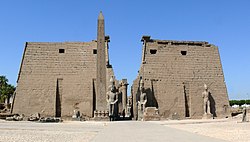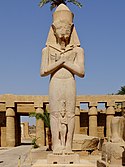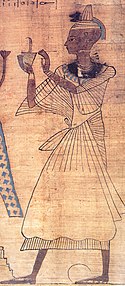Trajan offers to Hathor & Ra-Harakhte, Dendera
Relief panel from the impressive mammisi at Dendera dating mainly to the Roman period, these scenes depicting Emperor Trajan in Egyptian guise making offerings to Hathor. Much of the rich external carving was never finished, but on the south side it is fairly complete and in good condition (aside from the defaced Bes figures above the capitals).
The Temple of Hathor at Dendera is one of Egypt's best preserved and most beautiful ancient shrines. This magnificent edifice dates to the Ptolemaic period, late in Egyptian history, though the site long had been the cult centre for the goddess Hathor for centuries before (the earliest extant remains date to c360BC but a temple is recorded here as far back as c2250BC). Most of the main building dates to the reigns of the last Cleopatras and further decoration and building work within the complex continued in the Roman period up to the reign of Trajan.
The dominant structure in the complex is the Temple of Hathor, an enormous structure with a rectangular facade punctuated by the Hathor-headed columns of the hypostyle hall within. This hall is an architectural wonder, a masterpiece of ancient Egyptian design and decoration, which covers every surface and has been recently cleaned, revealing a superb astrological ceiling in all its original vibrant colours.
Sadly there was much iconoclasm here during the early Christian period and most of the reliefs of the walls and pillars have been defaced. Worse still is the damage to the 24 Hathor-head capitals: not one of the nearly a hundred huge faces of the goddess that once smiled down on this hall has been left unblemished, most with their features cruelly chiselled away.
The main temple building is otherwise structurally intact, and extends into further halls and chapels beyond, again with much relief decoration (much of which is again defaced). In one corner is an entrance to a crypt below, an unusual feature in Egyptian temple architecture consisting of several narrow passages adorned with carved relief decoration in good condition.
There are further sanctuaries and chapels above on the roof of the temple, accessed by a decorated staircase and including the room where the famous Dendera Zodiac was formerly located (today its place in the ceiling taken by a cast of the original, now displayed in Paris). The highest part of the roof complex is no longer accessible to tourists, but I can still recall making the ascent there on our first visit in 1992.
Several other buildings surround the main temple, the most impressive of which is the mammisi or 'birth-house'. This consists of a large rectangluar hall surrounded by a colonnade near the entrance to the site and has some well preserved relief decoration on its exterior. Most of this structure dates to the Roman period, but the ruins of its predecessor built under Nectanebo II (Egypt's last native pharoah) stand nearby.
Dendera temple is one of the most rewarding in Egypt and shouldn't be missed. It is one of the most complete and evocative ancient monuments in the country and its recent restoration has revealed a surprisingly extensive amount of colour surviving within (we were amazed by the dramatic contrast with the soot-blackened ceiling we'd beheld on our previous visit in the 1990s). Despite its relative youth (in Egyptian terms at least!) it is easily one of my favourite sites in Egypt.
en.wikipedia.org/wiki/Dendera_Temple_complexRelevante Bilder
Relevante Artikel
Ägyptischer TempelÄgyptische Tempel wurden für die offizielle Verehrung der Götter und zum Gedenken an die Pharaonen im alten Ägypten und in den Regionen unter ägyptischer Kontrolle gebaut. Tempel wurden als Häuser für die Götter oder Könige angesehen, denen sie geweiht waren. In ihnen vollzogen die Ägypter eine Vielzahl von Ritualen, die zentralen Funktionen der ägyptischen Religion: den Göttern Opfergaben darbringen, ihre mythologische Interaktionen durch Feste nachspielen und die Kräfte des Chaos abwehren. Diese Rituale wurden als notwendig erachtet, damit die Götter die Maat, die göttliche Ordnung des Universums, aufrechterhalten konnten. Die Beherbergung und Pflege der Götter war die Pflicht der Pharaonen, die daher enorme Mittel für den Bau und die Instandhaltung von Tempeln aufwandten. Aus der Notwendigkeit heraus delegierten die Pharaonen die meisten ihrer rituellen Pflichten an eine Schar von Priestern, aber der Großteil der Bevölkerung war von der direkten Teilnahme an den Zeremonien ausgeschlossen und durfte die heiligsten Bereiche eines Tempels nicht betreten. Nichtsdestotrotz war ein Tempel eine wichtige religiöse Stätte für alle Bevölkerungsschichten, die dorthin gingen, um zu beten, Opfergaben zu bringen und den darin wohnenden Gott um Orakel zu bitten. .. weiterlesen























